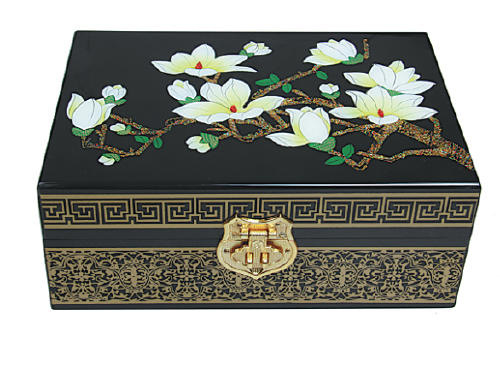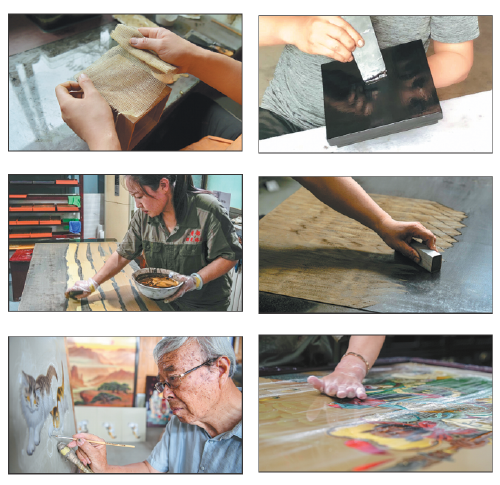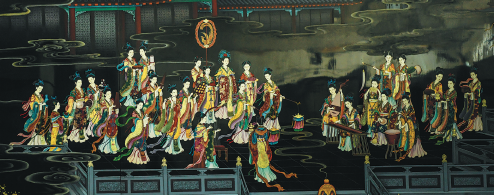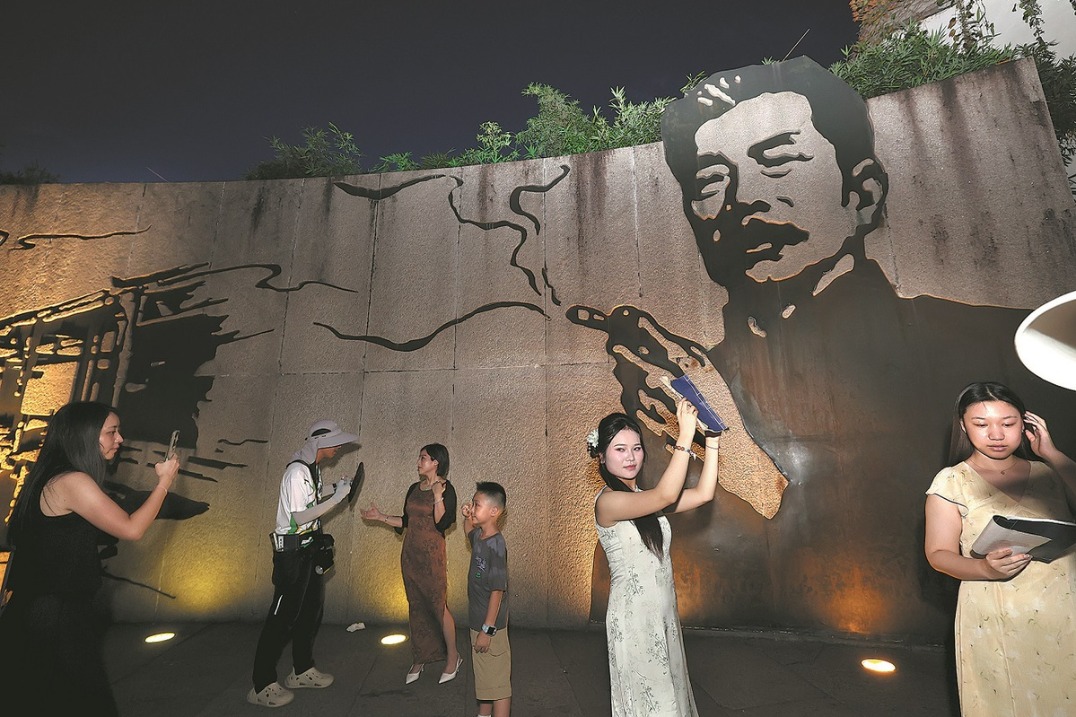Pingyao glazes a trail
Hand-polished lacquerware from an ancient Chinese town, promoted by a master artist and his dedicated disciples, is taking the world by storm, report Yang Feiyue in Beijing and Sun Ruisheng in Taiyuan.

For a bride-to-be in the ancient town of Pingyao, having a shining lacquer dresser in her trousseau is a must, its value no less than a coveted diamond ring or a family heirloom. Often painted with peonies or happily-ever-after tales, the lacquer dresser is meant to bless the newlyweds with marital bliss and prosperity.
Making the item an integral part of weddings shows people's appreciation of Pingyao's lacquerware, an art form that dates back more than 1,200 years to the Tang Dynasty (618-907).
As the ancient town in North China's Shanxi province became a national financial center under the Qing Dynasty (1644-1911), Pingyao's hand-polished lacquer art, fueled by the huge demand from wealthy bankers, reached its peak. The craft was among the first to be named a "national intangible cultural heritage" by the State Council in 2006.
Pingyao's lacquer art is known for its jade-like luster that comes from repeated hand-polishing. When the wood is manufactured into furniture, folding screens and tableware, it is first wrapped in linen and covered with a mixture of parget and pork blood for anticorrosion effects. It is then polished with sandpaper and covered with the mixture again. The process is repeated several times to create a surface smooth enough for later procedures.
Dexterous artists use lynx hair brushes to paint on the refined surface. The paintings are outlined with gold powder. Once done, the surface is covered with varnish, and hand-polished with sesame oil and brick dust over and over until a distinct sheen appears. A piece of lacquerware can take months or even years to finish.
"Lacquer art is the marriage between natural materials and intricate techniques," says Xue Shengjin, a master artist who has navigated the field for over six decades.
One of the 85-year-old's masterpieces, a lacquered decorative screen, features young women playing musical instruments while cranes kiss the clouds above a towering palace. The image is painted on smooth black lacquer, which is applied on an oak wood base for more than 100 times, rendering the work rich in color and gloss. It took Xue a year and a half to finish the screen that is 5 meters long and 3 meters tall.
Road to success
Xue was introduced to lacquer art by his father.
"My dad began making lacquerware from a very young age. He worked his way up from being an apprentice to the shopkeeper of a time-honored store in Pingyao," Xue says.
In 1953, at the age of 16, Xue started painting, inspired by local artists who created theatrical backgrounds at the Pingyao Cultural Scenery Society. Two years later, he had mastered the skill and was making a living out of it, and that was when he decided to seriously pursue the handicraft trade.
Opportunities came knocking in 1958, when a polished lacquer factory was founded in Pingyao. Xue was among the first artists to be recommended to work at the factory, where he was under the tutelage of lacquerware master Qiao Quanyu.
"Qiao held nothing back when he taught me, but the learning curve wasn't smooth," Xue says. Before they realized, the plant was on the verge of bankruptcy. "We had overstocked lacquerware and the going got really hard," he recalls. Everyone at the factory was scraping by on rustproof lacquer and glass painting they had produced.
It was not until 1964, when a Beijing company in foreign trade came along, bought all the lacquerware and placed new orders, that things turned around. The renewed appreciation of local lacquer art put the factory back on its feet.
By then, Qiao's health had deteriorated and Xue was at the helm of design and research. He referred to his erstwhile experience in painting and adopted critical innovation ideas to improve lacquerware designs. Not only did Xue restore lost lacquer art techniques, he also came up with a dozen new methods.
With the rise of local merchants under the Ming (1368-1644) and Qing rulers, Pingyao lacquer products were sold in Russia and Southeast Asian countries.
In the 1970s, polished lacquerware from Pingyao became a major contributor to Shanxi's foreign-exchange income and made its way to 20 countries and regions.
"Sales in France were the largest. The French liked distinct Chinese designs, particularly historical figures and rural scenery," Xue says.
An art as delicate as lacquerware-making can be very demanding. Aspiring artists need to train for at least three years to grasp basic polishing and painting techniques. According to Xue, more than eight years of practice is necessary to become proficient in the craft.
The complex process that covers wood selection, lacquer application, painting and polishing usually calls for joint efforts by multiple artists. They need to work in tandem to deliver delicate lacquerware, especially those inlaid with conch shells or gold foil.
New blood
In addition to furthering his own skills, Xue has started passing down his technical know-how to younger generations.
"Young people need to be passionate and persistent to understand the essence of lacquer art," he says.
Xue has groomed more than 200 apprentices, including his two sons.
"My father works with his apprentices for some five hours a day at the workshop," says Xue Xiaodong, one of his sons.
Xue Xiaodong has adhered to his father's commitment to natural lacquer and draws inspiration from traditional culture.
"It is important for us to know about ancient attire, literature and opera to make good lacquerware," he says.
Xue Xiaodong, on the other hand, has developed his own understanding of the craftsmanship. "It is imperative to integrate modern concepts, as aesthetic standards are constantly evolving, and creators need to study them to appeal to younger generations," he says.
In 2011, the Xue family founded a lacquer art research institute, where enthusiasts can learn the nitty-gritty of techniques. While traditional lacquerware highlights classic tales or auspicious patterns, younger artists like Xue Xiaodong strive to keep the art modern and simple.
At the institute, one can see lacquerware featuring medical workers fighting the pandemic. The human portraits have gold foil outline while the creases of clothes are finished with inlaid white shells, creating a three-dimensional effect.
Xue Shengjin is relieved to see the contribution from younger artists.
"The content and style of paintings can change as long as the craftsmanship stays intact," he says.
In recent years, Xue Shengjin has gotten a new identity. He is an honorary curator of the China Polished Lacquerware Museum in Pingyao, where visitors can feast their eyes on a splendid array of lacquer art, including jewelry boxes featuring Chinese zodiac animals from the Tangdu Polished Lacquerware Co. Other items like delicate tableware, bookmarks and personal accessories are also grabbing attention.
"We have combined traditional techniques with modern elements and stepped up research to expand application of the intangible cultural heritage," says Yin Jianping, the deputy general manager of the lacquerware company.
Yin has sensed the market trend in which Pingyao's polished lacquerware is making inroads into modern life.
"We will work with reputable and culturally creative companies to explore more possibilities," Yin says.
The popularity and influence of Pingyao's lacquerware are on the rise, thanks to online sales and expanding overseas markets. Top lacquer artists and businesses are rich resources for development of the art, says Huo Wenzhong, director of the Pingyao Intangible Cultural Heritage Protection Center.
Local authorities are also hosting a lacquer festival to build a communication platform for artists from around the world. The objective is to take Pingyao's polished lacquerware further, Huo adds.
Peng Ke'er contributed to this story.



Today's Top News
- Russia, China to continue working together for prosperity, says Putin
- AI set for greater policy support
- Chinese automakers climb in global top 10 sales rankings
- Xi stresses persistent efforts to improve Party conduct
- Strong Kazakh-Sino ties key to successful cooperation
- East–West concert honors war's victims






























